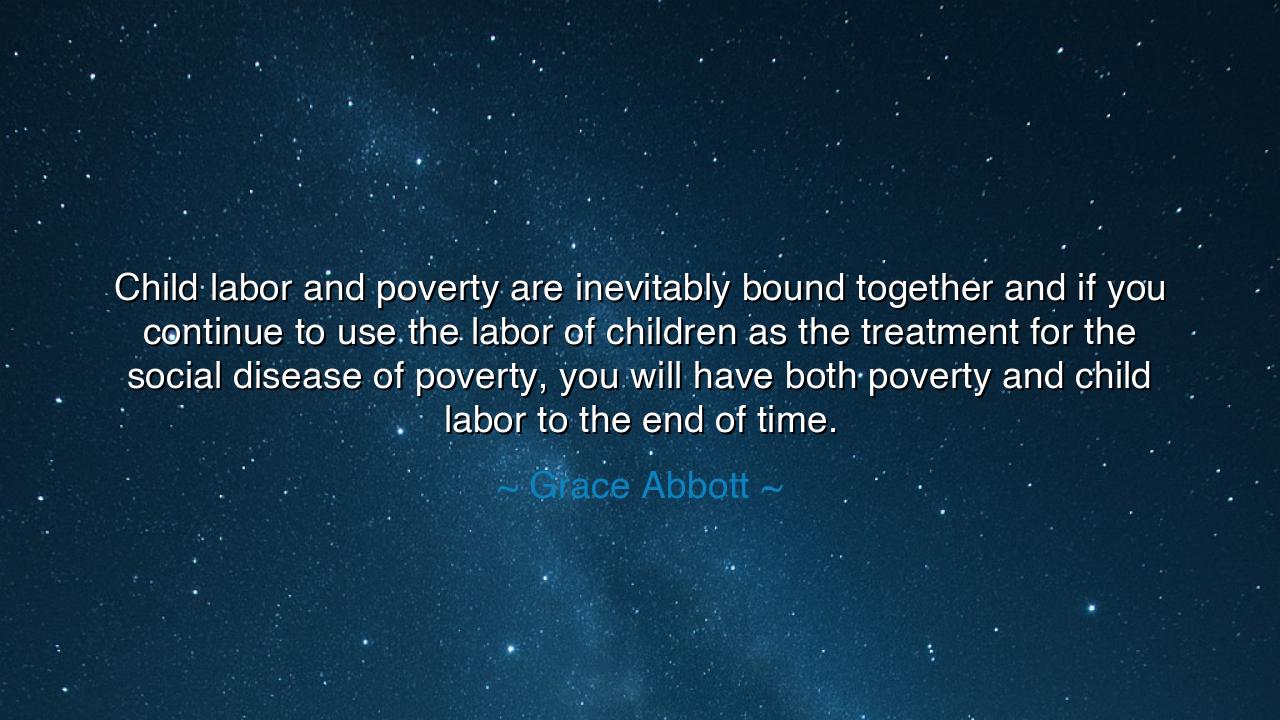
Child labor and poverty are inevitably bound together and if you
Child labor and poverty are inevitably bound together and if you continue to use the labor of children as the treatment for the social disease of poverty, you will have both poverty and child labor to the end of time.






The words of Grace Abbott—“Child labor and poverty are inevitably bound together and if you continue to use the labor of children as the treatment for the social disease of poverty, you will have both poverty and child labor to the end of time.”—thunder with the force of truth spoken on behalf of the voiceless. They are not words of comfort, but of warning, for they expose a vicious cycle that devours generations. Abbott, a fierce reformer of the early 20th century, spoke these words not in abstraction but from the battlefield of social struggle, where she saw with her own eyes the withered hands of children working when they should have been learning, dreaming, and growing.
In this truth we see the tragic logic of oppression: poverty drives families to send their children into toil, and the toil itself robs those children of the education and strength that might have lifted them out of poverty. Thus, child labor does not cure poverty; it perpetuates it. It is like pouring water into a broken jar—it may quench thirst for a moment, but the emptiness soon returns. Abbott’s voice was the cry of a prophet, warning society that unless the cycle is broken, both chains will remain unbroken, binding the poor forever.
History is heavy with this sorrow. In the factories of the Industrial Revolution, children worked from dawn until nightfall, their small bodies bent and broken by machines that demanded more than they could give. Families were told that their children’s wages were necessary for survival. Yet as the years passed, those children, robbed of learning, became adults with no skills beyond the labor of their youth, trapped in the same poverty their parents knew. This is the curse Abbott denounced: by feeding on the labor of the young, society condemned both present and future to despair.
And yet, where courage rose, hope broke through. In America, reformers like Abbott herself fought tirelessly for laws against child labor, insisting that schools, not factories, must shape the young. Slowly, legislation emerged, pulling children from the mines and mills, and placing them in classrooms. Over time, societies that heeded this wisdom grew stronger, for they understood that a child educated is not merely one mouth fed, but a foundation laid for prosperity. Where child labor was abolished, poverty itself began to retreat.
Beloved listener, the meaning is plain: no society that consumes the innocence of its children will ever prosper. To treat poverty with child labor is to treat sickness with poison. The true remedy lies in education, in opportunity, in lifting burdens from small shoulders and placing tools of knowledge in their hands. For every child forced into toil is a wasted seed of potential, and every child given learning is a tree that may shelter generations.
The lesson for us is both urgent and eternal. If you would fight poverty, fight for children to be free from the yoke of labor. Support schools, protect laws that shield the young, and give your strength to causes that defend their right to learn and grow. Do not turn a blind eye when you see the exploitation of the vulnerable, for silence feeds the cycle Abbott condemned. Each act of defense, each coin given, each voice raised for the young is a stone removed from the walls of poverty.
Practical wisdom demands action: value teachers, build schools, support families so that no parent must choose between hunger and their child’s education. Teach your own children to honor learning, and to see labor not as the fate of the small, but as the calling of the grown. Remember always that the future is not built on the backs of children, but in the freedom of their minds and hearts.
So let Abbott’s warning resound across the generations: child labor and poverty are inevitably bound together. Break one chain, and the other shall fall. Protect the children, and you protect the future; deny them, and you condemn both present and posterity to endless suffering. Let it be your legacy to stand with the children, and to ensure that their laughter, not their labor, becomes the song of tomorrow.






AAdministratorAdministrator
Welcome, honored guests. Please leave a comment, we will respond soon